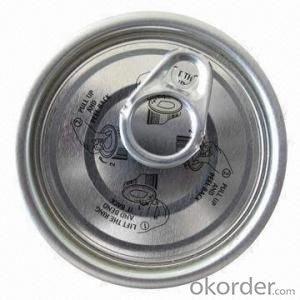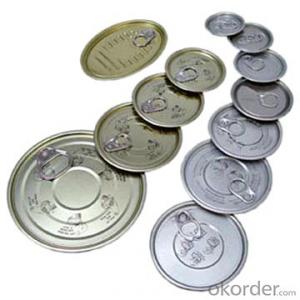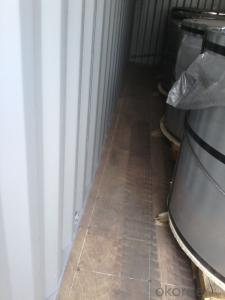Aluminum Material EOE with Best Quality, Model 300#
- Loading Port:
- Guangzhou
- Payment Terms:
- TT OR LC
- Min Order Qty:
- 100000 pc
- Supply Capability:
- 100000000 pc/month
OKorder Service Pledge
OKorder Financial Service
You Might Also Like
Specifications
aluminium tennis eoe
2.item num:300#
3.have saferim
4.size:72.9mm
5.type:full open
Name | aluminium tennis eoe |
Item No. | 300 # |
Shape/type | Round |
Size(mm) | Dia 72.9 |
Coating | Clear inside & outside |
Material | Aluminum |
Pcs/Carton | 3,000 Customize packing: as clients’ requests. |
Features |
1.Have saferim. 2.For tennis storage. 3.Coating can be according to customer required. |
Our packing
We could offer package as customers require, by carton or by wooden pallet.

Our Workshop


FAQ
1.Q: What is the material of EOE?
We can offer both tinplate and aluminum material made EOE;
2.Q:Could you offer samples for our testing?
YES, we could offer sampler for free if needed;
3. Q:Can you make new mold with customized size I need?
YES, We can make mold for you if reach some qty.
- Q: How is tinplate coated with protective lacquer?
- Tinplate is coated with protective lacquer by first cleaning and pre-treating the surface to remove any contaminants. Then, a thin layer of lacquer is applied onto the tinplate using various methods such as roller-coating or spray-coating. The lacquer acts as a barrier, protecting the tinplate from corrosion, oxidation, and other external factors that may affect its quality and durability.
- Q: Can tinplate packaging be used for personal care products?
- Yes, tinplate packaging can be used for personal care products. Tinplate is a suitable material choice for packaging personal care products such as lotions, creams, and cosmetics due to its durability, resistance to corrosion, and ability to protect the contents from external factors such as light and moisture. Additionally, tinplate packaging can be easily customized and decorated to enhance the product's appeal.
- Q: How does tinplate contribute to the circular economy?
- Tinplate contributes to the circular economy by being easily recyclable and having a long lifespan. It can be collected, sorted, and recycled multiple times without losing its properties, reducing the need for virgin materials. Additionally, tinplate's durability and corrosion resistance make it suitable for reuse, further extending its life cycle. This promotes resource efficiency, reduces waste, and minimizes environmental impact, making tinplate an important component in the circular economy.
- Q: How does tinplate compare to other types of packaging materials?
- Tinplate has several advantages over other types of packaging materials. It is highly durable, providing excellent protection for the contents. Tinplate also has good resistance to corrosion, ensuring the product remains fresh and uncontaminated. Additionally, it is lightweight and easily recyclable, making it an environmentally friendly option. Furthermore, tinplate offers a visually appealing and versatile packaging solution, with various printing and shaping options available.
- Q: Can tinplate packaging be used for promotional items?
- Yes, tinplate packaging can definitely be used for promotional items. Tinplate packaging is a versatile and customizable option that can be designed to display brand logos, messages, and captivating visuals. It provides a durable and attractive packaging solution that can enhance the perception of the promotional item and leave a lasting impression on recipients.
- Q: Can tinplate be used for packaging of organic products?
- Yes, tinplate can be used for packaging of organic products. Tinplate is a type of steel coated with a thin layer of tin, providing excellent protection against corrosion and ensuring food safety. It is widely used in the packaging industry, including for organic products, as it is considered a safe and sustainable packaging material.
- Q: How does tinplate contribute to the overall sustainability of the supply chain?
- Tinplate contributes to the overall sustainability of the supply chain in several ways. Firstly, it is a highly recyclable material, which means that it can be reused multiple times without compromising its quality. This reduces the need for virgin materials and minimizes waste generation. Secondly, tinplate has excellent barrier properties, protecting the contents of the packaging from external factors such as light, moisture, and oxygen, thus reducing food waste and extending shelf life. Additionally, tinplate is lightweight yet sturdy, enabling efficient transportation and reducing carbon emissions during shipping. Overall, tinplate's recyclability, protective properties, and transportation efficiency make it a sustainable choice in the supply chain.
- Q: What is the average lifespan of tinplate packaging?
- The average lifespan of tinplate packaging varies depending on various factors such as storage conditions, handling, and usage. However, when properly maintained, tinplate packaging can last for several years, providing durable protection for the packaged goods.
- Q: Tin can weldingHow can the side of the column of the pop top be welded or pressed?,
- Mainly divided into the tank, the tank cover and the tank bottom three parts. The tank body is made of a piece of iron material through the curl bending machine, by using copper welder and welding. Now the mainstream of aerosol cans, food cans and beverage cans are produced by this method.
- Q: Can tinplate be used for packaging cosmetics?
- Yes, tinplate can be used for packaging cosmetics. Tinplate is a popular choice for cosmetic packaging due to its durability, corrosion resistance, and ability to maintain product quality. It provides a protective barrier against external elements, ensuring the longevity of the product. Additionally, tinplate is easily printable, allowing for attractive and eye-catching designs on cosmetic packaging.
Send your message to us
Aluminum Material EOE with Best Quality, Model 300#
- Loading Port:
- Guangzhou
- Payment Terms:
- TT OR LC
- Min Order Qty:
- 100000 pc
- Supply Capability:
- 100000000 pc/month
OKorder Service Pledge
OKorder Financial Service
Similar products
Hot products
Hot Searches
Related keywords



























